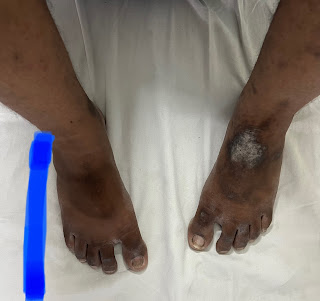MY EXPERIENCE IN MEDICINE DEPARTMENT
This in D.Naga Sai Rohith Naidu a medical student from India. Welcome to my blog .I came to postings when I am in my 3rd semester i don't know how to take a case, what are the things to ask ,how to examine a patient ,how to present myself towards a patient how to present a case, slowly with my pgs and with my hod help i learned how to take a proper history of a patient .
As it is very clear that Case taking and history taking are fundamental aspects of the medical practice. They play a crucial role in gathering relevant information about a patient's condition, which helps in making an accurate diagnosis and developing an appropriate treatment plan. With the help of this Case taking and history taking provided me an opportunity to establish a rapport with the patients. I established a patient and doctor relationship which feels so excited to me.
This blog system helps us to keep every information together in a place which is very useful.
NOTE: THIS IS AN ONLINE E LOGBOOK TO DISCUSS OUR PATIENT'S DE-IDENTIFIED HEALTH DATA SHARED AFTER TAKING HIS/HER GUARDIAN'S SIGNED INFORMED CONSENT. HERE WE DISCUSS OUR INDIVIDUAL PATIENT'S PROBLEMS THROUGH A SERIES OF INPUTS FROM THE AVAILABLE GLOBAL ONLINE COMMUNITY OF EXPERTS INTENDING TO SOLVE THOSE CLINICAL PROBLEMS WITH COLLECTIVE CURRENT BEST EVIDENCE-BASED INPUT.
Coming to my case
https://dnagasairohith38.blogspot.com/2023/01/42-yr-old-male-with-abdominal-distension.html
That was my 6th sem ,i posted in the department of general medicine ,That was an op day.
There were full of patients in the general medicine op there I encountered this Case of 42 year old male patient complaining with abdominal distention since 10 Days ,Swelling In Both the legs since 5 Days ,As I examined him we came to a conclusion that he had ascites.
I am so excited to examine this patient for the 1st tym I checked for fluid thrill, puddle sign ,shifting dullness which are positive .
Then I send the investigations to further confirm the diagnosis
Liver function tests (such as liver enzyme levels), kidney function tests, and blood cell counts are performed
Ascitic fluid analysis: Ascitic fluid is a sample of the fluid extracted from the abdominal cavity through a procedure called paracentesis. The fluid is then analyzed to determine its composition and help identify the cause of ascites.
Analysis shows cell count ,This determines the number and types of cells present in the fluid. It can help differentiate between infection, malignancy.Protein and albumin levels in the ascitic fluid can provide information about the severity and underlying cause of ascites. Ascitic fluid may be cultured to identify the presence of bacteria or other microorganisms and determine the appropriate antibiotic treatment if there is an infection.Cytology -ascitic fluid may be examined under a microscope to check for the presence of cancer cells.



Comments
Post a Comment